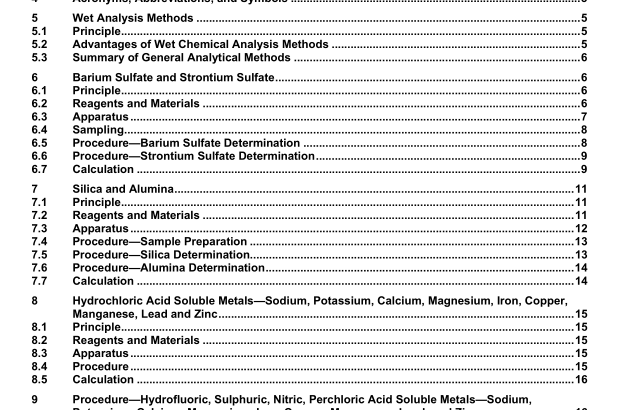API RP 13K:2011 pdf free download.Recommended Practice for Chemical Analysis of Barite
15 Water-soluble Phosphates
15.1 Principle
Water-soluble phosphates, both ortho and condensed, are determined colorimetrically by use of the Hach ® 5 premixed reagents PhosVer III ® 6 , or equivalent. A sample of the filtrate from the water extraction of the barite sample (Section 11) is heated in the presence of excess acid to convert all phosphates to orthophosphate. Color is developed by the addition of PhosVer III reagent, which contains ammonium molybdate and ascorbic acid. An intense blue color is formed if phosphate is present, and the intensity of the color is measured with a spectrophotometer at a wavelength of 700 nm. IC may be used as an alternative for phosphate determinations.
15.2 Reagents and Materials
15.2.1 Sulfuric acid (CAS #7664-93-9), ACS reagent grade (98 %).
Caution—Concentrated sulfuric acid is a strong, potentially harmful acid. Use proper safety precautions.
15.2.2 Sulfuric acid (CAS #7664-93-9) solution (5.25N), 143 ml H 2 SO 4 /1 l solution.
15.2.3 Sodium hydroxide (CAS #1310-73-2), ACS reagent grade.
Caution—Concentrated sodium hydroxide is a strong, potentially harmful acid. Use proper safety precautions.
15.2.4 Sodium hydroxide (CAS #1310-73-2) solution (5.0N), 200 g NaOH/1 l solution.
15.2.5 Sodium phosphate (CAS #10361-03-2), ACS reagent grade, (NaPO 4 • 12H 2 O).
15.2.6 Standard phosphate stock (CAS #10361-03-2) solution (1000 mg/l PO 4 −3 ), 1.726 g sodium phosphate/1 l solution.
15.2.7 Hach PhosVer III , or equivalent, phosphate reagent powder pillows.
15.2.8 Distilled water.
15.3 Apparatus
15.3.1 Spectrophotometer or filter photometer, capable of measuring absorbance at a wavelength of 700 nm.
15.3.2 Erlenmeyer flasks , several 125 ml.
15.3.3 Graduated mixing cylinders , with stoppers, several 25 ml.
15.3.4 Volumetric pipettes , several of various sizes.
15.3.5 Volumetric flasks , several 100 ml.
15.3.6 Hot plate .
15.3.7 Graph paper , linear.
15.4 Procedure—Preparation of Calibration Curve
15.4.1 Prepare standard solutions containing 0.25 mg/l, 0.50 mg/l, 1.00 mg/l, and 2.00 mg/l PO 4 −3 by serial dilution of the stock phosphate standard solution.
15.4.2 Transfer 25 ml of each solution to a 125-ml Erlenmeyer flask. Prepare a reagent blank using 25 ml of distilled water.
15.4.3 Add 2.0 ml of 5.25N sulfuric acid and boil gently on a hot plate for 30 min, maintaining sample volume at 15 ml to 20 ml by additions of distilled water.
15.4.4 After 30 min, remove from the hot plate, cool to room temperature, add 2.0 ml of 5.0N sodium hydroxide solution, and transfer to the 25-ml graduated mixing cylinders.
15.4.5 Add the contents of one PhosVer III, reagent pillow, dilute to the 25-ml mark with distilled water. Stopper and mix.
15.4.6 Wait at least 2 min but no more than 10 min, then measure the absorbance at the wavelength of 700 nm, using a sample cell or tube with a path length of 25 mm (1 in.). Zero the instrument using the reagent blank.
15.4.7 Prepare a calibration curve by plotting phosphate ion concentration versus absorbance on linear graph paper.
15.5 Procedure—Analysis of Samples
15.5.1 Transfer 5 ml of the barite-water leachate from Section 11 to a 125-ml Erlenmeyer flask and add sufficient distilled water to bring total volume to 25 ml.
15.5.2 Proceed with steps from above, 15.4.3 through 15.4.6.
15.5.3 Determine the phosphate content, in mg/l, in the final 25 ml solution by reference to the previously prepared calibration curve.
15.5.4 If the phosphate ion content is below the range of the calibration curve, take a larger portion of the barite- water leachate from Section 11. If the phosphate ion content is above the range of the calibration curve, prepare a volumetric dilution and take an appropriate aliquot. In any case, record the actual volume of the original filtration that was present in the solution in which the color was developed.
15.6 Calculation
where
is the concentration of phosphate, expressed in mg/l;
is the phosphate ion concentration reading from the calibration curve, expressed in mg/l;
is the volume of barite-water leachate sample, expressed in ml.
16 Loss on Ignition
16.1 Principle
The LOI of barite ores is the weight loss after heating to 1000 °C (1832 °F). The LOI can be due to several things,including the following.
a) Moisture—rarely over 0.1 % to 0.2 %, and usually not separately determined.
b) Combined water—from clays, hydrated iron oxides, gypsum, and other accessory minerals.
c) Organic and carbonaceous matter.API RP 13K pdf download.API RP 13K:2011 pdf free download
